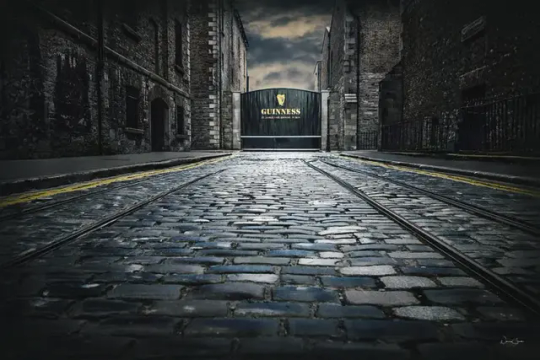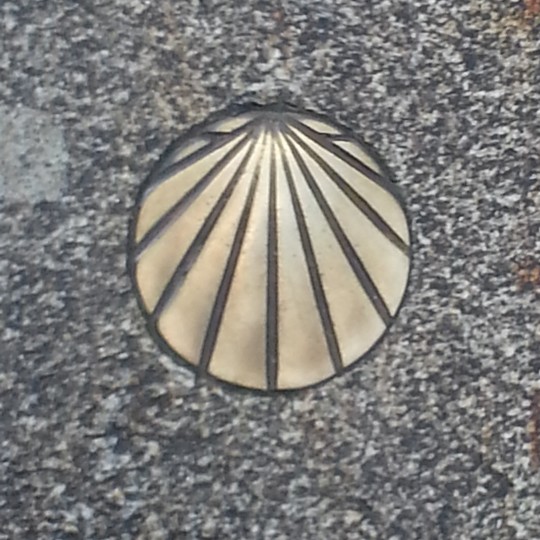#st. james
Explore tagged Tumblr posts
Text
Santiago

(by request)
A few years ago, I went to Santiago de Campostela. To the Cathedral that marks the end of the legendary pilgrim’s way known simply as “The Camino.”
Don’t be impressed. I did it the easy way. By driving from Portugal.
Atop the main altar at the Cathedral is a larger-than-life-size statue of St. James. In a Baroque sanctuary dripping with gold and silver, the ornate statue of St. James stands out.
The treasured relics of the Apostle could not be in a more precious container.
But that’s not where they are.
The actual relics of St. James are at the bottom of a cramped flight of stairs, worn smooth by the feet of centuries of pilgrims. In a simple shrine in a narrow crypt.
Underneath the main altar. And a world away from the bejeweled splendor overhead.
I love beautiful churches. The glories of the great cathedrals and the beauty of Catholic art and worship are some of the things that God used to draw me to the Church. And still uses to draw me closer to Him.
But there was something wonderfully poetic about the simplicity of the actual resting place of St. James. I remember thinking, as I stood there in the little shrine, “we have this treasure in earthen vessels,” (which is today’s first reading).
It was a wonderful visual for the extravagance of God. How God treats not just His Apostles, but all of His beloved. How God treats you and me.
God pours out His love. God pours out His care. God pours out His compassion. God pours out His very best into our hearts. Into the simple, flawed, fragile vessels of you and me.
Not even asking whether we’re good enough. Not waiting until we’re perfect.
But looking at us with Holy love. Wanting so much for us. That He can’t wait.
God pours out the greatest treasure – God’s love, God’s forgiveness, God’s very best – into our hearts. The moment we turn to Him and take our first halting steps towards Home.
Today’s Readings
#Perfect#Earthen Vessels#Extravagant#God's Beloved#Good Enough#God#Jesus#Catholic#Christian#Church#St. James#Santiago#Moments Before Mass
27 notes
·
View notes
Text

L’avantage de travailler dans le quartier de St. James’s à Londres est que j’ai régulièrement l’occasion de voir beaucoup de belles vieilles voitures britanniques dans les rues. - source Paul Hier.
30 notes
·
View notes
Text
Open House Chicago 2024 - Day 1
October 19-20, 2024
Sponsored by the Chicago Architecture Center
Cathedral Hall, University Club of Chicago, 76 East Monroe Street
1909, Martin Roche, architect, Frederic Clay Bartlett, stained glass windows






Murphy Auditorium, 50 E. Erie Street
1926, Benjamin Marshall and Charles E. Fox of Marshall and Fox, architects




St. James Cathedral, Huron and Wabash Streets
1875, Edward Burling, architect


Lawson House, formerly Lawson YMCA, 803 N Dearborn Street
1931, Perkins, Chatten, and Hammond, architects; Edgar Miller, designer of the Chapel








#Open House Chicago#2024#Chicago Architecture Center#architecture#chicago#buildings#photography#art deco#sculpture#history#Lawson#YMCA#Murphy Auditorium#University Club#Cathedral Hall#Episcopal Cathedral#St. James
8 notes
·
View notes
Text

Alter in St. James' Church, Hamburg, Germany
11 notes
·
View notes
Text

Troparion for St. James, tone 4.
As the Lord’s disciple you received the Gospel, O righteous James;
as a martyr you have unfailing courage;
as God’s brother, you have boldness;
as a hierarch, you have the power to intercede.//
Pray to Christ God that our souls may be saved.
#my name day#st. james#st. james the brother of the lord#orthodoxy#orthodox christianity#Ο αγιος ιακωβος ο αδελφοθεος
2 notes
·
View notes
Photo

St. Jakobus der Apostel, ca. 1612-13 von Peter Paul Rubens (Öl auf Holz)
#kunst#kunstwerk#art#artwork#peter paul rubens#künstler#artist#religion#religiöse kunst#religious art#mann#man#jakobus#james#st. jakobus#st. james#apostel#apostle#jünger#disciple#jesus christ#christ#christus#jesus#glaube#faith#beten#pray#bibel#bible
5 notes
·
View notes
Text

Fountain, St. James Cathedral, Seattle, 2014.
#fountain#cathedral#st. james#seattle#washington state#2014#photographers on tumblr#pnw#pacific northwest
7 notes
·
View notes
Text
SAINT OF THE DAY (July 25)

James, the brother of John the Evangelist, was the first Apostle to be martyred. He was beheaded by order of Herod of Agrippa.
The Gospels tell us that the two brothers left their father Zebedee and followed Jesus as soon as He called out to them.
James was one of the three Apostles who were particularly close to the Lord. He was there with the Lord, his brother John, and Peter at the Transfiguration and in the Garden of Gethsemane.
He is known as "James the Greater" to distinguish him from the other Apostle by the same name.
The title has little to do with his function or the people's regard for him. Rather, it was a term indicating that he was the elder of the two.
He is the patron saint of Spain and of pilgrims.
In northwestern Spain, he is venerated at Santiago de Compostela, a medieval pilgrimage site that is still very popular today.
—
Santiago de Compostela or Compostela is the capital of the autonomous community of Galicia in northwestern Spain.
The city has its origin in the shrine of Saint James the Great, now the Cathedral of Santiago de Compostela, as the destination of the Way of St. James, a leading Catholic pilgrimage route since the 9th century.
In 1985, the city's Old Town was designated a UNESCO World Heritage Site.
#Saint of the Day#St. James#St. James the Greater#Santiago de Compostela#St. James the Great#Way of St. James
14 notes
·
View notes
Text
#OTD – Today is the Feast Day of St. James.
Since mediaeval times, Dubliners held an annual drinking festival in the Saint’s honour. Fittingly, Guinness chose St. James’ Gate as the site for their brewery. St. James is the patron saint of hatmakers, rheumatoid sufferers, and labourers. St James the Greater was one of the first disciples of Jesus and is believed to be the first of the 12 apostles to be martyred. He was the son of Zebedee…

View On WordPress
#Dublin#Guinness Brewery#History#History of Ireland#Ireland#Irish History#St James Gate#St. James#Today in Irish History
14 notes
·
View notes
Text


Fields
#nature#nature photography#rural photography#photography#photography on tumblr#original photography#digital photography#photographers on tumblr#fields#grassy fields#saint james#st. james#green#blue
15 notes
·
View notes
Text
Walking the Camino de Santiago
March 11, 2023 It felt like, rightly or wrongly, we should take a trip. Everyone we know was going somewhere. It is winter vacation time for many of our friends as they “get away” from winter. The winter travelersmade me think: what type of past trips have we enjoyed the most, anytime? And the one that stood out was walking the Camino de Santiago in the Fall of 2012. We walked from Leon to…

View On WordPress
4 notes
·
View notes
Video
youtube
Amazing Sacred Fruit #performance by Rieko Whitfield singing & Ġulja Holland painting at the exhibition A New Gothic Malta
#youtube#art#exhibition#Ġulja Holland#Rieko Whitfield#amazing#inspirational#Sacred Fruit#shows happening#Malta#st. james#A New Gothic#performance#culture
2 notes
·
View notes
Text

What the actual fuck?
#What the actual fuck?#intermountain health#st. james foundation#st. james#st. james hospital#health#mental health#healthcare#health & fitness#health and wellness#healthylifestyle#ausgov#politas#auspol#tasgov#taspol#australia#fuck neoliberals#neoliberal capitalism#anthony albanese#albanese government#class war#eat the rich#eat the fucking rich#eat the 1%#hospital#oppression#repression#late stage capitalism#fuck capitalism
0 notes
Text
CryptoCrewClan
CryptoCrewClan is a clan discuss mentally and physically by #CryptoDan on has birthday this clan only focus on Compassionate|Confident| Conscientious. Fully #CryptoCrewClan Created by Duan O Rose (CryptoDan)
0 notes
Text
Teejay Joins Son Jaydon & Quada On "Star"
As a parent, it’s important to build a legacy for your offspring to follow. No matter the profession, seeing your child/children follow in your footsteps or even being inspired by your journey is a special feeling. Dancehall Artist Teejay knew he would have some of his proudest moments as a Father when he shared the spotlight with his son, Nathaniel, who goes by the stage name Jaydon (and…
#13thstreetpromo#13thstreetpromotions#blog#dancehall#I Am Chippy#jamaica#jamaican#Jaydon#Jedi The God#music#music video#Quada#riddim#St. James#Star#Teejay#video#wordpress#youtube
0 notes
Text
Peregrinations and Pilgrimages: Legendary Scallops
A long time ago, I read a novel about a young woman who made the pilgrimage to Santiago de Compostela. The story captivated me, true. But more than that, the legend of the scallops stayed with me, with its magical aura of place, embodying the enduring desire of people to journey on pilgrimage, eternally seeking. The Codex Calixtinus (more HERE about this, also called Liber sancti Jacobi, Book of…
0 notes